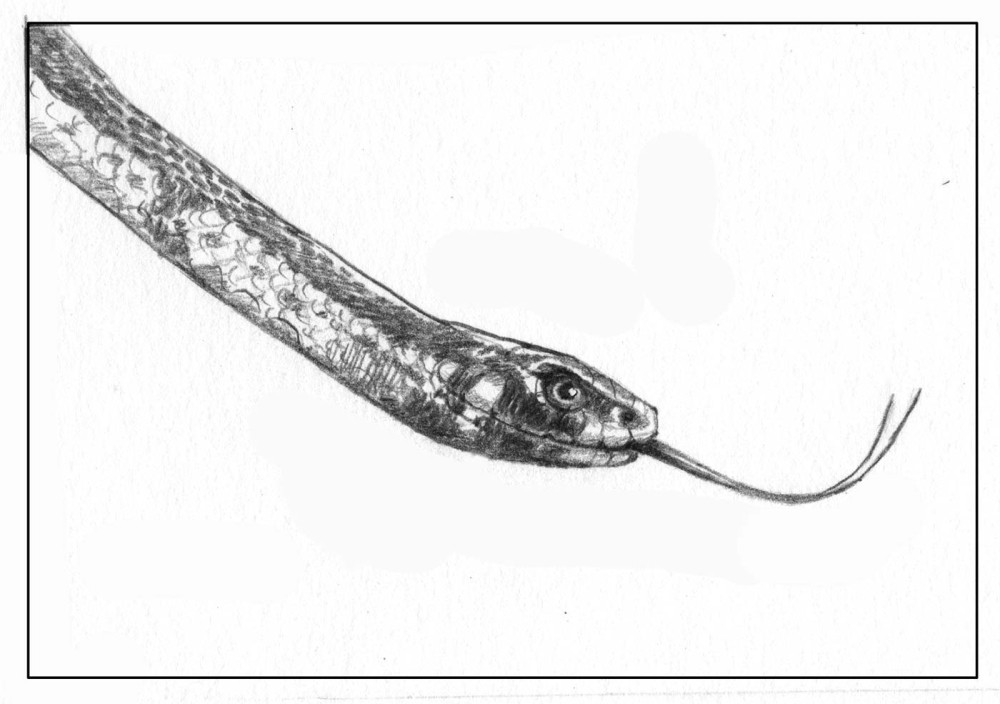
Walking down my road on an early June afternoon several years ago, I spotted a snake attempting to cross into the underbrush. Covered in colorful splotches, it quickly slithered across the pavement and out of sight. I knew this wasn’t a gartersnake, a familiar visitor to my garden, and later identified the reptile as a milksnake. This was my first encounter with the species, and while I spotted another milk snake two years later, I might be hard-pressed to see one again. Milksnakes are secretive and largely nocturnal.
The eastern milksnake (Lampropeltis triangulum triangulum) is brown or gray with red-brown blotches on its back and a black-and-white checkerboard pattern along its belly. A light-colored Y- or V-shaped marking on a milk snake’s head points toward its tail. Normally 2 to 3 feet in length, some milksnakes may grow to 4 feet or more, and the average size reported in Vermont is 40 inches, according to the Vermont Reptile and Amphibian Atlas. Milksnakes in our region tend to be more brown-colored, while western milksnakes are reddish in hue.
Milksnakes can sometimes be confused for rattlesnakes due to their tapered tails and quick tail movements. When a milksnake vibrates its tail very quickly in dry leaves, it sounds very similar to the noise of a rattlesnake’s rattle. However, unlike rattlesnakes, eastern milksnakes lack a physical rattle and are non-venomous.
Eastern milksnakes live throughout the Northeast, except in the uppermost reaches of Vermont, New Hampshire, and Maine. The snake’s range extends south into Georgia and as far west as Oklahoma. Milksnakes survive our northern winters by retreating into hibernacula. These sites may include stone walls, barns, or basements.
These snakes live in both forested and more open habitats. “They can frequently be found under rocks and debris in abandoned agricultural areas and grassy meadows, and under logs in and along the edges of woodlands,” Whit Gibbons wrote in his book, Snakes of the Eastern United States. Their regular proximity to barns contributed to the false belief that milksnakes drink cow’s milk. In reality, it’s the availability of rodents and sources of cover at farms that attracts milksnakes.
Mating season occurs in May or June, with clutches as large as two dozen eggs laid inside logs or in clumps of vegetation. Baby snakes emerge two months later. As milksnakes grow, their diet expands to include fish, earthworms, small birds, slugs, insects, rodents, amphibians, and smaller snakes. A milksnake detects food sources by “smell,” using its flickering tongue to collect scent particles, then interpret those with a specialized organ in its mouth. The snake then hunts or ambushes its prey, which it will swallow whole, usually after constricting larger prey animals.
Hawks, carnivorous mammals, and larger snakes such as racers all prey on the eastern milksnake. When threatened, a milksnake will move its tail rapidly, emit musk, and may bite. However, the snake will typically stay still or try to escape first. In general, all snakes attempt to avoid confrontation. Creatures of the night, milksnakes spend their days basking in secret places or hiding out under convenient sources of protective cover such as logs or rocks. By doing so, they can evade natural predators as well as humans.
Like many snake species, eastern milksnakes are threatened by habitat loss, road mortality, and deliberate targeting by hostile humans. As Gibbons noted in his book, “The best hope to protect the natural habitats of snakes and prevent malicious killing lies in changing public attitudes through education.” With increased awareness about the role that milksnakes (and others) play in controlling rodent populations, more people can learn to coexist with this non-venomous species that inhabits our backyards, farms, and forests.
This summer, if you happen to see a milksnake in your garden or exiting your stone wall, don't grab a shovel. Instead, control the reflexive shudder that accompanies snake sightings for many people, and acknowledge a misunderstood and maligned animal that has survived despite increasingly tough odds. Our native snakes deserve some understanding – and, perhaps, even some love.


Discussion *